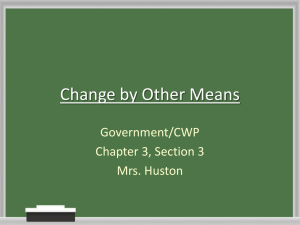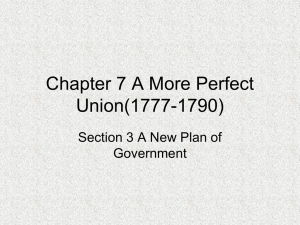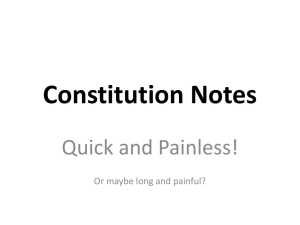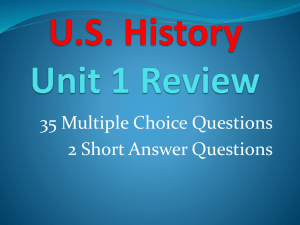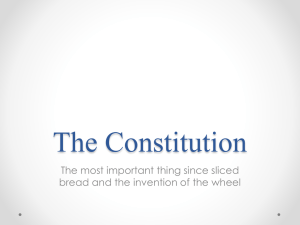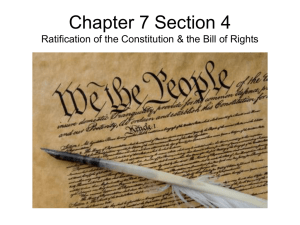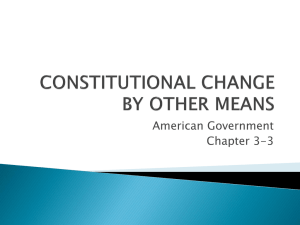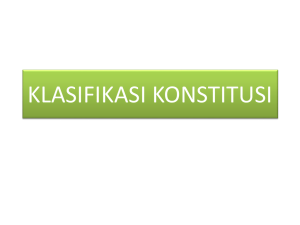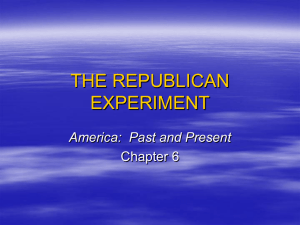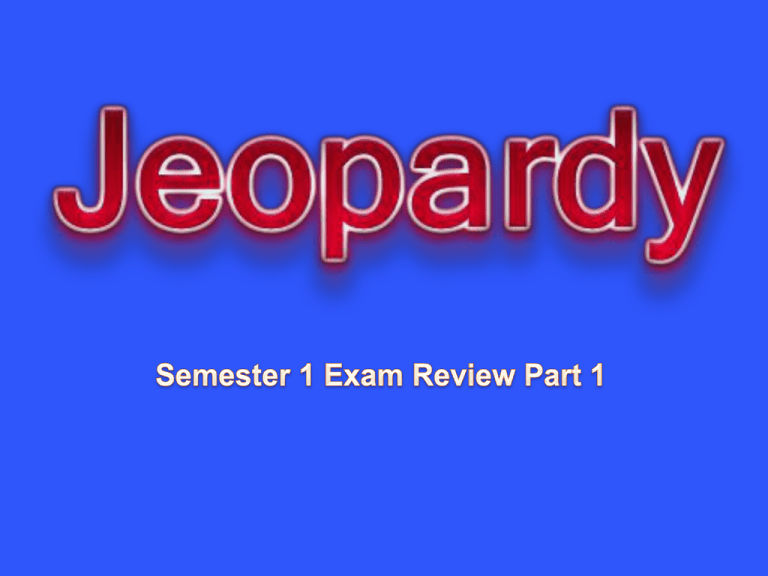
Topic 1
Topic 2
Topic 3
Topic 4
Topic 5
10
10
10
10
10
20
20
20
20
20
30
30
30
30
30
40
40
40
40
40
50
50
50
50
50
Question 1 - 10
Among the broad purposes of the United States
government spelled out in the Preamble to
the Constitution is the obligation to
a. keep the executive and legislative branches of
government separate.
b. create an autocratic form of government.
c. defend the country against Americans who
oppose its policies.
d. provide for justice and the people's general
welfare.
Answer 1 – 10
d. provide for justice and the people's general
welfare.
Question 1 - 20
Locke, Harrington, Hobbes, and Rousseau
would most likely agree that
a. the state developed out of force.
b. those of royal birth should rule the state.
c. the state exists to serve the will of the people.
d. government should be eliminated.
Answer 1 – 20
c. the state exists to serve the will of the people.
Question 1 - 30
The dominant political unit in the world today
is the
a. government.
c. Constitution.
b. nation.
d. state.
Answer 1 – 30
d. state.
Question 1 - 40
A federal government is one in which
a. all power is concentrated in the central
government.
b. limited powers are assigned to a central
agency by independent states.
c. power is divided between a central
government and local governments.
d. powers are divided between a legislative
branch and an executive branch.
Answer 1 – 40
c. power is divided between a central
government and local governments.
Question 1 - 40
The individual 50 States lack which basic
characteristic of a state?
a. government
c. Constitution
b. sovereignty
d. defined population
Answer 1 – 40
b. sovereignty
Question 1 - 50
The Internet seems especially suited to satisfy
which of these needs in a democracy?
a. to control the lives of citizens
b. to be informed about the many different
institutions and policies of the government
c. the need for accurate, and always reliable,
information on which to base decisions
d. the need for an uneducated elite to run the
government
Answer 1 – 50
b. to be informed about the many different
institutions and policies of the government
Question 2 - 10
Which of the following statements about
sovereign states is NOT true?
a. Sovereign states decide their own foreign and
domestic policies.
b. Sovereign states can determine their own
form of government.
c. A county or city is considered sovereign
because it is subordinate to a larger form of
government.
d. Sovereign states have supreme power within
their own territories.
Answer 2 – 10
c. A county or city is considered sovereign
because it is subordinate to a larger form of
government
Question 2 - 20
In a democracy, the will of the majority
a. cannot be changed or improved upon.
b. is not open to compromise.
c. rarely leads to satisfactory policy decisions.
d. cannot be used to deprive rights to a member
of a minority group.
Answer 2 – 20
d. cannot be used to deprive rights to a member
of a minority group.
Question 2 - 30
Which statement about the social contract
theory is NOT true?
a. The state was created voluntarily by a free
people.
b. The state is a natural extension of people's
family structure.
c. Governmental powers are granted by the
people.
d. Governmental powers may be limited by the
people.
Answer 2 – 30
b. The state is a natural extension of people's
family structure.
Question 2 - 40
Which of the following illustrates the concept
of equality of opportunity?
a. Public schools may not exclude students
because of their sex or race.
b. Citizens must obey the tax laws but may work
to change them.
c. Government may limit the beliefs and ideas of
individuals.
d. Senators consider testimony both for and
against Supreme Court nominees.
Answer 2 – 40
a. Public schools may not exclude students
because of their sex or race.
Question 2 - 50
Which idea is NOT included in the Declaration
of Independence?
a. People have certain natural rights.
b. God gives certain people the right to govern.
c. Government can exist only with the people's
permission.
d. The people may change or abolish the
government.
Answer 2 – 50
b. God gives certain people the right to govern.
Question 3 - 10
Which feature did the State constitutions and
the Articles of Confederation have in
common?
a. royal governors
b. bill of rights
c. principle of popular sovereignty
d. a strong executive elected by popular vote
Answer 3 – 10
c. principle of popular sovereignty
Question 3 - 20
In Benjamin Franklin's opinion, the final
Constitution created by the delegates can
best be summarized as
a. absolutely perfect.
b. as near perfect as possible.
c. showing errors of opinion and self-interest.
d. as full of imperfections as those who
assembled it.
Answer 3 – 20
b. as near perfect as possible.
Question 3 - 30
A major objective of both the Annapolis
Convention and the Philadelphia
Convention was to
a. determine how the States should be
represented in Congress.
b. recommend a federal plan for regulating
interstate trade.
c. raise n army for quelling incidents like
Shay'sRebellion.
d. limit the growing power of the National
Government.
Answer 3 – 30
b. recommend a federal plan for regulating
interstate trade.
Question 3 - 40
The Federalist was written to
a. win support for the Constitution in New York.
b. expose the lack of civil liberties protected in
the Constitution.
c. urge ratification of the Constitution in Virginia.
d. condemn the Constitution for the absence of
any mention of God.
Answer 3 – 40
a. win support for the Constitution in New York.
Question 3 - 50
Benjamin Franklin's attitude toward the new
constitution may be summarized as a
combination of
a. despair and hope.
b. astonishment and optimism.
c. relief and anger.
d. fatigue and thankfulness.
Answer 3 – 50
b. astonishment and optimism.
Question 4 - 10
Much of the work of the Framers centered
around the proposals that had been set out
in
a. the Virginia Plan.
b. the New Jersey Plan.
c. The Federalist.
d. the Declaration of Independence.
Answer 4 – 10
a. the Virginia Plan.
Question 4 - 20
Which statement about the Bill of Rights is NOT
true?
a. The amendments arose from the controversy
over ratification of the Constitution.
b. The amendments were ratified at the same
time as the Constitution.
c. The amendments guarantee such basis rights
as freedom of expression and fair and equal
treatment before the law.
d. The amendments are the first ten of the
Constitution.
Answer 4 – 20
b. The amendments were ratified at the same
time as the Constitution
Question 4 - 30
Which of the following best describes the
concept of limited government?
a. Powers are divided among three independent
branches of government.
b. All political power belongs to the people.
c. Government must operate within certain
bounds set by the people.
d. The people must behave according to rules
set by the government.
Answer 4 – 30
c. Government must operate within certain
bounds set by the people.
Question 4 - 40
Which of the following is a method of formal
amendment?
a. proposal by three-fourths of the House of
Representatives and ratification by conventions in
three-fourths of State legislatures
b. proposal by two-thirds of the Senate and
ratification by two-thirds of State legislatures
c. proposal by two-thirds of Congress and ratification
by three-fourths of State legislatures
d. all of the above
Answer 4 – 40
c. proposal by two-thirds of Congress and
ratification by three-fourths of State
legislatures
Question 4 - 50
Which of the following is NOT true of the use
of executive agreement?
a. It extends the President's power through the
informal amendment process.
b. It carries the same legal force as a treaty.
c. It can be used to avoid the lengthy treatymaking process.
d. It is among the executive powers listed in
Article II of the Constitution.
Answer 4 – 50
d. It is among the executive powers listed in
Article II of the Constitution
Question 5 - 10
The President's power to veto an act of
Congress is an example of
a. executive agreement.
b. judicial review.
c. checks and balances.
d. limited government.
Answer 5 – 10
• c. checks and balances.
Question 5 - 20
Which of the following accounts for the ability
of the Constitution to endure for more than
200 years?
a. built-in provisions for accommodating change
b. detailed provisions that anticipated changing
customs
c. very specific language that limits
reinterpretation
d. inflexible provisions designed to resist change
Answer 5 – 20
a. built-in provisions for accommodating change
Question 5 - 30
Which of the following is NOT an example of
the checks and balances system?
a. The President makes an executive agreement.
b. The Supreme Court declares a law passed by
Congress to be unconstitutional.
c. The President vetoes a bill.
d. The Senate approves the President's nominee
for Supreme Court justice.
Answer 5 – 30
a. The President makes an executive agreement.
Question 5 - 40
When there is a separation of powers,
a. power is divided between the National
Government and the States.
b. power is distributed among three
independent branches of government.
c. the people grant the States the authority to
govern.
d. the basic powers of government are held by a
single agency.
Answer 5 – 40
b. power is distributed among three
independent branches of government.
Question 5 - 50
Congress can informally amend the
Constitution by
a. passing basic legislation.
b. adding meaning to skeletal portions of the
Constitution.
c. simply exercising many of its powers.
d. all of the above.
Answer 5 – 50
d. all of the above.

